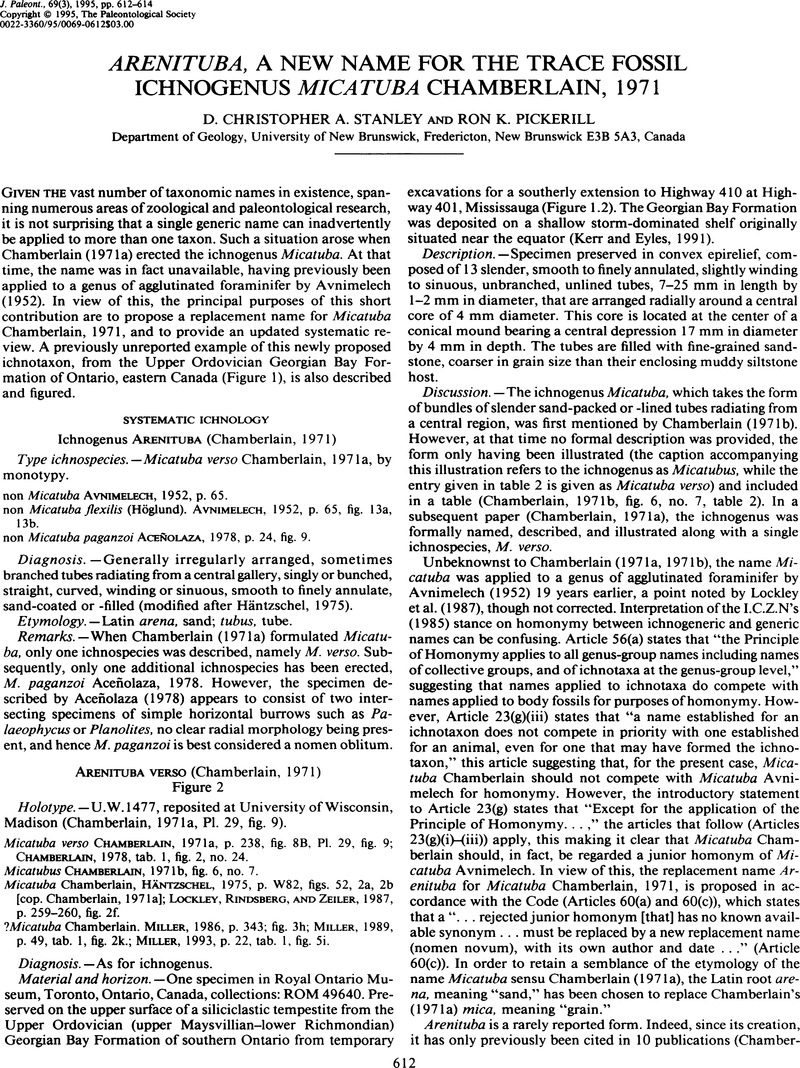Crossref Citations
This article has been cited by the following publications. This list is generated based on data provided by Crossref.
Zhang, Guocheng
Buatois, Luis A.
Mángano, M.Gabriela
and
Aceñolaza, Florencio G.
1998.
Sedimentary facies and environmental ichnology of a ?Permian playa-lake complex in western Argentina.
Palaeogeography, Palaeoclimatology, Palaeoecology,
Vol. 138,
Issue. 1-4,
p.
221.
Uchman, Alfred
Hanken, Nils-Martin
and
Binns, Richard
2005.
Ordovician Bathyal Trace Fossils From Metasiliciclastics in Central Norway and Their Sedimentological and Paleogeographical Implications.
Ichnos,
Vol. 12,
Issue. 2,
p.
105.
Schlirf, Michael
and
Uchman, Alfred
2005.
Revision of the ichnogenussabellarifexrichter, 1921 and its relationship toskolithoshaldeman, 1840 andpolykladichnusfürsich, 1981.
Journal of Systematic Palaeontology,
Vol. 3,
Issue. 2,
p.
115.
HEARD, THOMAS G.
and
PICKERING, KEVIN T.
2008.
Trace fossils as diagnostic indicators of deep‐marine environments, Middle Eocene Ainsa‐Jaca basin, Spanish Pyrenees.
Sedimentology,
Vol. 55,
Issue. 4,
p.
809.
Knaust, Dirk
2008.
Balanoglossites Mägdefrau, 1932 from the middle triassic of Germany: part of a complex trace fossil probably produced by burrowing and boring polychaetes.
Paläontologische Zeitschrift,
Vol. 82,
Issue. 4,
p.
347.
Bradshaw, Margaret A.
2010.
Devonian Trace Fossils of the Horlick Formation, Ohio Range, Antarctica: Systematic Description and Palaeoenvironmental Interpretation.
Ichnos,
Vol. 17,
Issue. 2,
p.
58.
Uchman, Alfred
2010.
A new ichnogenus Skolichnus for Chondrites hoernesii Ettingshausen, 1863, a deep-sea radial trace fossil from the Upper Cretaceous of the Polish Flysch Carpathians: Its taxonomy and palaeoecological interpretation as a deep-tier chemichnion.
Cretaceous Research,
Vol. 31,
Issue. 5,
p.
515.
Bayliss, Nicole J.
and
Pickering, Kevin T.
2015.
Deep-marine structurally confined channelised sandy fans: Middle Eocene Morillo System, Ainsa Basin, Spanish Pyrenees.
Earth-Science Reviews,
Vol. 144,
Issue. ,
p.
82.
Knaust, Dirk
2015.
Siphonichnidae (new ichnofamily) attributed to the burrowing activity of bivalves: Ichnotaxonomy, behaviour and palaeoenvironmental implications.
Earth-Science Reviews,
Vol. 150,
Issue. ,
p.
497.
Wetzel, Andreas
Uchman, Alfred
and
Bromley, Richard G.
2016.
Underground Miners Come Out to the Surface – Trails of Earthworms.
Ichnos,
Vol. 23,
Issue. 1-2,
p.
99.
Kopaska-Merkel, David C.
and
Rindsberg, Andrew K.
2016.
Bioirrigation inAlphn. igen., arthropod cubichnia from the Mississippian Hartselle Sandstone of Alabama (USA).
Geodinamica Acta,
Vol. 28,
Issue. 1-2,
p.
117.
Buatois, Luis A.
Wisshak, Max
Wilson, Mark A.
and
Mángano, M. Gabriela
2017.
Categories of architectural designs in trace fossils: A measure of ichnodisparity.
Earth-Science Reviews,
Vol. 164,
Issue. ,
p.
102.
Donovan, Stephen K.
MacNaughton, Robert B.
Keighley, David G.
Pemberton, S. George
and
Gingras, Murray K.
2019.
Obituary: Ron K. Pickerill (1947–2018).
Ichnos,
Vol. 26,
Issue. 4,
p.
303.
Muñoz, Diego F.
Mángano, M. Gabriela
and
Buatois, Luis A.
2019.
Unravelling Phanerozoic evolution of radial to rosette trace fossils.
Lethaia,
Vol. 52,
Issue. 3,
p.
350.
El-Refaiy, Ahmed A.
El-Sabbagh, Ahmed M.
Hedeny, Magdy M. El
Mansour, Ahmed S.
and
El-Barkooky, Ahmed N.
2023.
Stratigraphical, microfacies, and ichnological characteristics and depositional environments of the Permo‒Carboniferous Aheimer Formation, western side of the Gulf of Suez, Egypt.
Facies,
Vol. 69,
Issue. 2,
Zouheir, Tariq
Hminna, Abdelkbir
Saber, Hafid
Klein, Hendrik
Lagnaoui, Abdelouahed
Voigt, Sebastian
Rmich, Aziz
Schneider, Joerg W.
and
Lucas, Spencer G.
2023.
Ichnodiversity and facies of Triassic red beds in the Irohalene area (Argana Basin, Western High Atlas, Morocco): implications for palaeoenvironment.
Historical Biology,
Vol. 35,
Issue. 6,
p.
875.
Harris, Brette S.
Olariu, Cornel
Melnyk, Scott
LaGrange, Maya T.
Konhauser, Kurt O.
and
Gingras, Murray K.
2024.
Aratichnus
igen. nov. from the Eocene-aged Baronia Formation, Àger Basin, Lleida, Spain
.
Ichnos,
p.
1.





